instrument panel CITROEN C3 2023 Owners Manual
[x] Cancel search | Manufacturer: CITROEN, Model Year: 2023, Model line: C3, Model: CITROEN C3 2023Pages: 104, PDF Size: 2.38 MB
Page 4 of 104
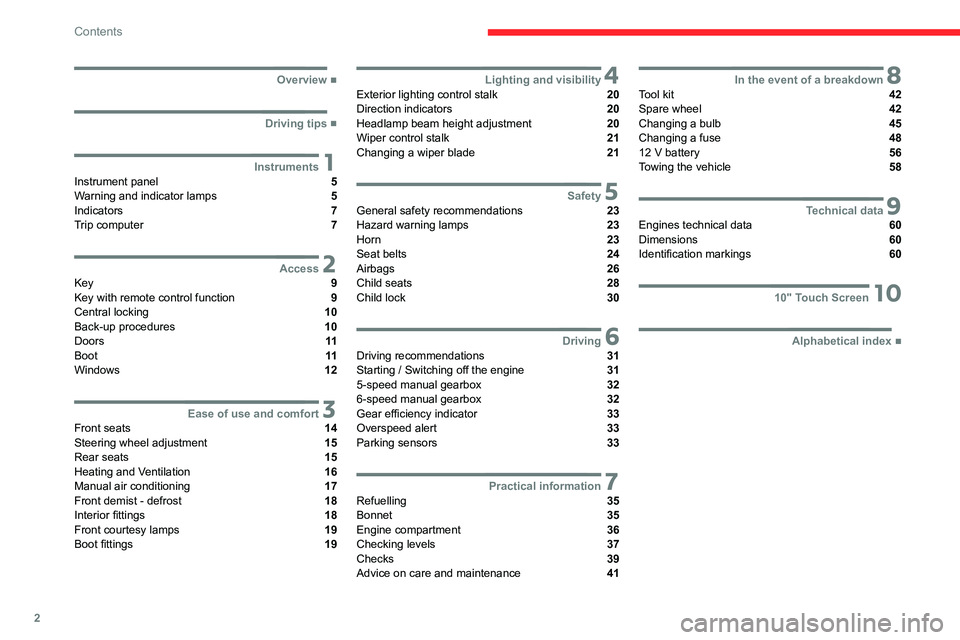
2
Contents
■
Overview
■
Driving tips
1InstrumentsInstrument panel 5
Warning and indicator lamps 5
Indicators 7
Trip computer 7
2AccessKey 9
Key with remote control function 9
Central locking 10
Back-up procedures 10
Doors 11
Boot 11
Windows 12
3Ease of use and comfortFront seats 14
Steering wheel adjustment 15
Rear seats 15
Heating and Ventilation 16
Manual air conditioning 17
Front demist - defrost 18
Interior fittings 18
Front courtesy lamps 19
Boot fittings 19
4Lighting and visibilityExterior lighting control stalk 20
Direction indicators 20
Headlamp beam height adjustment 20
Wiper control stalk 21
Changing a wiper blade 21
5SafetyGeneral safety recommendations 23
Hazard warning lamps 23
Horn 23
Seat belts 24
Airbags 26
Child seats 28
Child lock 30
6DrivingDriving recommendations 31
Starting / Switching off the engine 31
5-speed manual gearbox 32
6-speed manual gearbox 32
Gear efficiency indicator 33
Overspeed alert 33
Parking sensors 33
7Practical informationRefuelling 35
Bonnet 35
Engine compartment 36
Checking levels 37
Checks 39
Advice on care and maintenance 41
8In the event of a breakdownTool kit 42
Spare wheel 42
Changing a bulb 45
Changing a fuse 48
12
V battery 56
Towing the vehicle 58
9Technical dataEngines technical data 60
Dimensions 60
Identification markings 60
1010" Touch Screen
■
Alphabetical index
Page 5 of 104
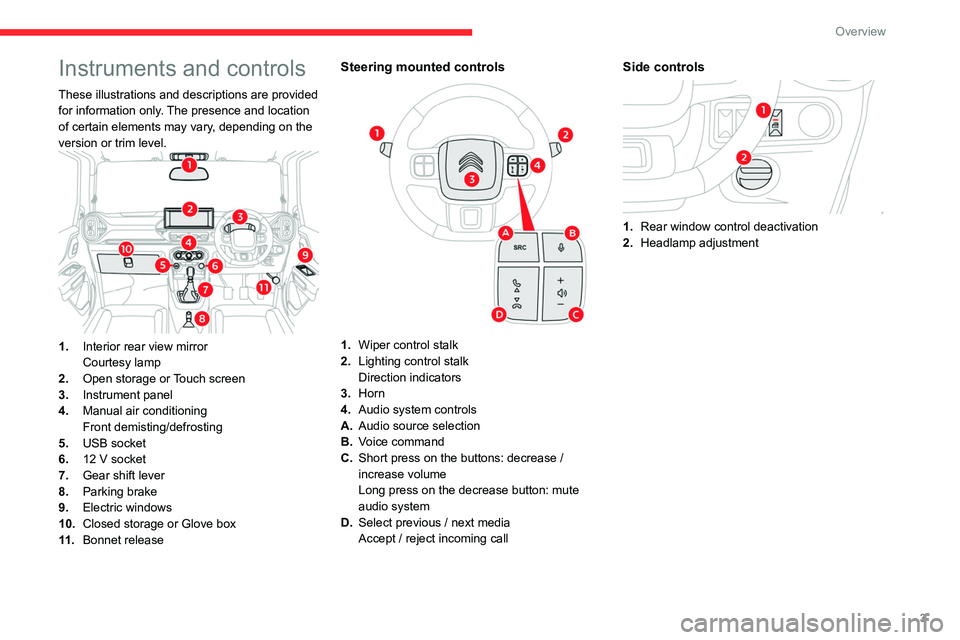
3
Overview
Instruments and controls
These illustrations and descriptions are provided
for information only. The presence and location
of certain elements may vary, depending on the
version or trim level.
1.Interior rear view mirror
Courtesy lamp
2. Open storage or Touch screen
3. Instrument panel
4. Manual air conditioning
Front demisting/defrosting
5. USB socket
6. 12 V socket
7. Gear shift lever
8. Parking brake
9. Electric windows
10. Closed storage or Glove box
11 . Bonnet release
Steering mounted controls
1.Wiper control stalk
2. Lighting control stalk
Direction indicators
3. Horn
4. Audio system controls
A. Audio source selection
B. Voice command
C. Short press on the buttons: decrease
/
increase volume
Long press on the decrease button: mute
audio system
D. Select previous
/ next media
Accept
/ reject incoming call
Side controls
1.Rear window control deactivation
2. Headlamp adjustment
Page 7 of 104

5
Instruments
1Instrument panel
1.Display screen
2. Trip computer button
Display screen
1.Speedometer
2. Gear shift indicator
3. Trip meter A/B
Odometer (ODO)
Average Fuel Economy (AFE)
Distance To Empty (DTE)
Illumination level 4.
Applicable units for displayed information
5. Service indicator
6. Fuel lid cap direction indication
7. Fuel gauge
8. Engine coolant temperature (°C)
Warning and indicator
lamps
Displayed as symbols, the warning and indicator
lamps inform the driver of the occurrence of a
malfunction (warning lamps) or of the operating
status of a system (operation or deactivation
indicator lamps). Certain lamps light up in two
ways (fixed or flashing) and/or in several colours.
Associated warnings
The illumination of a lamp may be accompanied
by an audible signal and/or a message displayed
in a screen.
Relating the type of alert to the operating status
of the vehicle allows you to determine whether
the situation is normal or whether a fault has
occurred: refer to the description of each lamp
for further information.
When the ignition is switched on
Certain red or orange warning lamps come on
for a few seconds when the ignition is switched
on. These warning lamps should go off as soon
as the engine is started.
For more information on a system or a function,
refer to the corresponding section.
Warning lamp continuously
lit
The illumination of a red or orange warning lamp
may indicate the occurrence of a fault that needs
further investigation.
If a warning lamp remains lit
The references (1), (2) and (3) in the warning
and indicator lamp description indicate whether
you should contact a qualified professional in
addition to the immediate recommended actions.
(1): You must stop the vehicle .
Stop as soon as it is safe to do so and switch off
the ignition.
(2): Contact a CITROËN dealer.
(3): Visit a CITROËN dealer.
List of warning and
indicator lamps
Red warning/indicator lamps
STOP
Fixed, associated with another warning
lamp, accompanied by an audible signal
(single tone buzzer).
It indicates a serious fault with the engine,
low engine oil & coolant temperature warning,
braking system, airbag malfunction or a major
electrical fault.
Carry out (1) and then (2).
Page 9 of 104

7
Instruments
1Black/white warning lamps
Service
Flashing.
A fault has been detected.
Carry out (3).
Fixed.
The servicing interval has been
exceeded.
Your vehicle must be serviced as soon as
possible. Carry out (3).
Indicators
Service indicator
The vehicle servicing must be done according to
the distance covered (kilometres or miles) or the
time elapsed since the last service.
The servicing alert is given at whichever of these
two terms is reached first.
Service indicatorFixed, when the ignition is switched on.
The next service is due.
Have your vehicle serviced very soon.
Engine coolant temperature
indicator
With the engine running:
– In zone A, the temperature is correct.
–
In zone
B, the temperature is too high; the
associated warning lamp comes on in red on the
instrument panel, accompanied by an audible
signal.
You must stop the vehicle as soon as it is
safe to do so.
Wait a few minutes before switching off the
engine.
After switching off the ignition, carefully open the bonnet and check the coolant
level.
For more information on Checking
levels, refer to the corresponding
section.
Trip computer
Data displayed
► Make a short press on the button located
on the instrument panel to display and switch
between the following information:
–
Odometer
–
T
rip A
–
T
rip B
–
A
verage Fuel Economy (AFE)
–
Distance
To Empty (DTE)
–
Illumination level (park lamp on then press the
trip button to adjust the illumination level of the
cluster)
Page 10 of 104
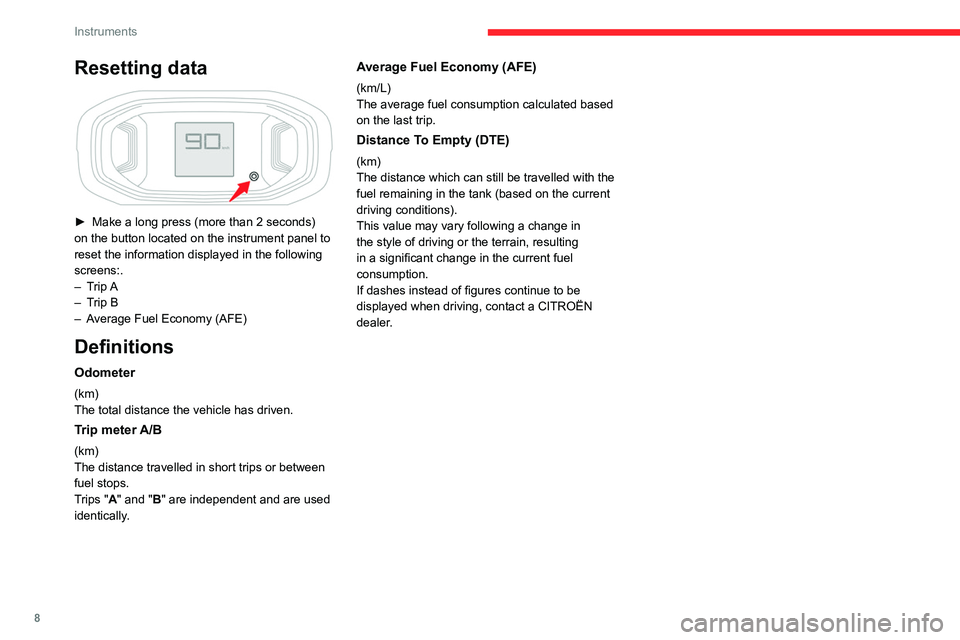
8
Instruments
Resetting data
► Make a long press (more than 2 seconds)
on the button located on the instrument panel to
reset the information displayed in the following
screens:.
–
T
rip A
–
T
rip B
–
A
verage Fuel Economy (AFE)
Definitions
Odometer
(km)
The total distance the vehicle has driven.
Trip meter A/B
(km)
The distance travelled in short trips or between
fuel stops.
Trips "A" and "B" are independent and are used
identically.
Average Fuel Economy (AFE)
(km/L)
The average fuel consumption calculated based
on the last trip.
Distance To Empty (DTE)
(km)
The distance which can still be travelled with the
fuel remaining in the tank (based on the current
driving conditions).
This value may vary following a change in
the style of driving or the terrain, resulting
in a significant change in the current fuel
consumption.
If dashes instead of figures continue to be
displayed when driving, contact a CITROËN
dealer.
Page 16 of 104

14
Ease of use and comfort
Correct driving position
For safety reasons, adjustments must
only be made when the vehicle is
stationary.
Before taking to the road and to make the most
of the ergonomic layout of the instruments and
controls, carry out these adjustments in the
following order:
–
seat backrest angle.
–
seat cushion height.
–
longitudinal seat position.
–
steering wheel height.
–
rear view mirror and door mirrors.
–
seat belt fastened.
Once these adjustments have been
made, check that the instrument panel
can be viewed correctly from your driving
position.
Front seats
Before moving the seat backwards,
ensure that there is nothing that might
prevent the full travel of the seat.
There is a risk of trapping or pinching
passengers if present in the rear seats or
jamming the seat if large objects are placed
on the floor behind the seat.
Longitudinal adjustment
► Raise the control bar and slide the seat
forwards or backwards.
►
Release the bar to lock the seat in position on
one of the runners.
Backrest angle adjustment
► Raise the control lever to the maximum
height in order to avoid noise and mechanism
failure.
Height adjustment
(Driver only, depending on version)
► Raise or lower the control as many times as
needed.
Avoid stepping on these plastic parts - Risk of injury or damaging the
components!
Page 27 of 104
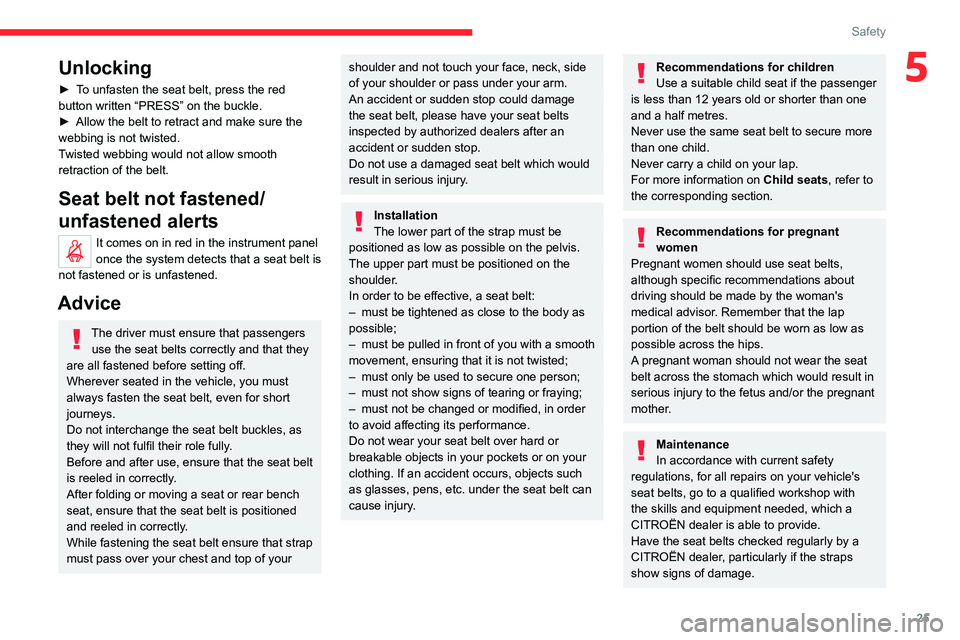
25
Safety
5Unlocking
► To unfasten the seat belt, press the red
button written “PRESS” on the buckle.
►
Allow the belt to retract and make sure the
webbing is not twisted.
T
wisted webbing would not allow smooth
retraction of the belt.
Seat belt not fastened/
unfastened alerts
It comes on in red in the instrument panel
once the system detects that a seat belt is
not fastened or is unfastened.
Advice
The driver must ensure that passengers use the seat belts correctly and that they
are all fastened before setting off.
Wherever seated in the vehicle, you must
always fasten the seat belt, even for short
journeys.
Do not interchange the seat belt buckles, as
they will not fulfil their role fully.
Before and after use, ensure that the seat belt
is reeled in correctly.
After folding or moving a seat or rear bench
seat, ensure that the seat belt is positioned
and reeled in correctly.
While fastening the seat belt ensure that strap
must pass over your chest and top of your
shoulder and not touch your face, neck, side
of your shoulder or pass under your arm.
An accident or sudden stop could damage
the seat belt, please have your seat belts
inspected by authorized dealers after an
accident or sudden stop.
Do not use a damaged seat belt which would
result in serious injury.
Installation
The lower part of the strap must be
positioned as low as possible on the pelvis.
The upper part must be positioned on the
shoulder.
In order to be effective, a seat belt:
–
must be tightened as close to the body as
possible;
–
must be pulled in front of you with a smooth
movement, ensuring that it is not twisted;
–
must only be used to secure one person;
–
must not show signs of tearing or fraying;
–
must not be changed or modified, in order
to avoid affecting its performance.
Do not wear your seat belt over hard or
breakable objects in your pockets or on your
clothing. If an accident occurs, objects such
as glasses, pens, etc. under the seat belt can
cause injury
.
Recommendations for children
Use a suitable child seat if the passenger
is less than 12 years old or shorter than one
and a half metres.
Never use the same seat belt to secure more
than one child.
Never carry a child on your lap.
For more information on Child seats, refer to
the corresponding section.
Recommendations for pregnant
women
Pregnant women should use seat belts,
although specific recommendations about
driving should be made by the woman's
medical advisor. Remember that the lap
portion of the belt should be worn as low as
possible across the hips.
A pregnant woman should not wear the seat
belt across the stomach which would result in
serious injury to the fetus and/or the pregnant
mother.
Maintenance
In accordance with current safety
regulations, for all repairs on your vehicle's
seat belts, go to a qualified workshop with
the skills and equipment needed, which a
CITROËN dealer is able to provide.
Have the seat belts checked regularly by a
CITROËN dealer, particularly if the straps
show signs of damage.
Page 29 of 104
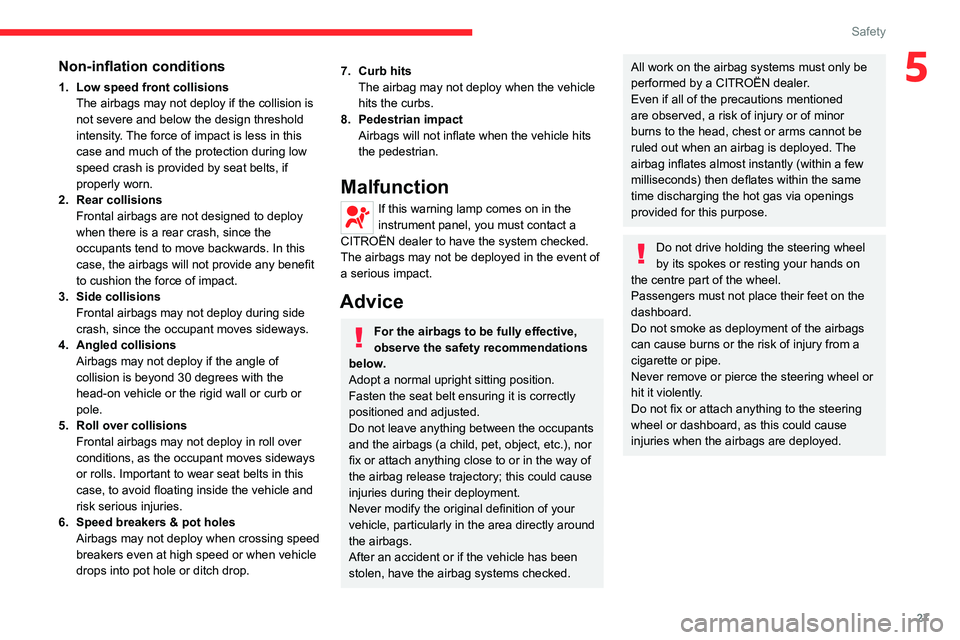
27
Safety
5Non-inflation conditions
1. Low speed front collisionsThe airbags may not deploy if the collision is
not severe and below the design threshold
intensity. The force of impact is less in this
case and much of the protection during low
speed crash is provided by seat belts, if
properly worn.
2. Rear collisions Frontal airbags are not designed to deploy
when there is a rear crash, since the
occupants tend to move backwards. In this
case, the airbags will not provide any benefit
to cushion the force of impact.
3. Side collisions Frontal airbags may not deploy during side
crash, since the occupant moves sideways.
4. Angled collisions Airbags may not deploy if the angle of
collision is beyond 30 degrees with the
head-on vehicle or the rigid wall or curb or
pole.
5. Roll over collisions Frontal airbags may not deploy in roll over
conditions, as the occupant moves sideways
or rolls. Important to wear seat belts in this
case, to avoid floating inside the vehicle and
risk serious injuries.
6. Speed breakers & pot holes Airbags may not deploy when crossing speed
breakers even at high speed or when vehicle
drops into pot hole or ditch drop.7. Curb hitsThe airbag may not deploy when the vehicle
hits the curbs.
8. Pedestrian impact Airbags will not inflate when the vehicle hits
the pedestrian.
Malfunction
If this warning lamp comes on in the
instrument panel, you must contact a
CITROËN dealer to have the system checked.
The airbags may not be deployed in the event of
a serious impact.
Advice
For the airbags to be fully effective,
observe the safety recommendations
below.
Adopt a normal upright sitting position.
Fasten the seat belt ensuring it is correctly
positioned and adjusted.
Do not leave anything between the occupants
and the airbags (a child, pet, object, etc.), nor
fix or attach anything close to or in the way of
the airbag release trajectory; this could cause
injuries during their deployment.
Never modify the original definition of your
vehicle, particularly in the area directly around
the airbags.
After an accident or if the vehicle has been
stolen, have the airbag systems checked.
All work on the airbag systems must only be
performed by a CITROËN dealer.
Even if all of the precautions mentioned
are observed, a risk of injury or of minor
burns to the head, chest or arms cannot be
ruled out when an airbag is deployed. The
airbag inflates almost instantly (within a few
milliseconds) then deflates within the same
time discharging the hot gas via openings
provided for this purpose.
Do not drive holding the steering wheel
by its spokes or resting your hands on
the centre part of the wheel.
Passengers must not place their feet on the
dashboard.
Do not smoke as deployment of the airbags
can cause burns or the risk of injury from a
cigarette or pipe.
Never remove or pierce the steering wheel or
hit it violently.
Do not fix or attach anything to the steering
wheel or dashboard, as this could cause
injuries when the airbags are deployed.
Page 35 of 104

33
Driving
6Only engage reverse gear when the
vehicle is stationary with the engine at
idle.
As a safety precaution and to facilitate starting the engine:
–
Always select neutral.
–
Press the clutch pedal.
Gear efficiency indicator
This system helps reduce fuel consumption by
recommending the most appropriate gear.
Operation
The system advises to change gear.The information appears in the instrument panel in the form of an ascending or
descending arrow.
The number displayed is the current gear.
Gear shift recommendations should not be
considered compulsory. In fact, the road layout,
the traffic density and safety remain the deciding
factors when choosing the best gear. The driver
therefore remains responsible for deciding
whether or not to follow the indications issued by
the system.
This function cannot be deactivated.
The system adapts its gear shift recommendation according to the driving
conditions (slope, load, etc.) and the driver’s
requirements (power, acceleration, braking,
etc.).
The system never suggests:
–
engaging first gear;
–
engaging reverse.
Overspeed alert
An audible overspeed alert is triggered when the
vehicle exceeds predefined speed thresholds.
When the vehicle speed is greater than 80 km/h,
the alert is emitted every 2 minutes.
When the vehicle speed is greater than 120
km/h, the alert is emitted every 2 seconds.
This system cannot be modified nor deactivated.
Parking sensors
Using sensors located in the bumper, this
system signals the proximity of obstacles
(e.g.
pedestrian, vehicle, tree, barrier) present in
their field of detection.
Rear parking sensors
The system is switched on by engaging reverse
gear.
The system is switched off when disengaging
reverse gear.
Audible assistance
The system signals the presence of obstacles
within the sensors’ detection zone.
The proximity information is given by an
intermittent audible signal, the frequency of
which increases as the vehicle approaches the
obstacle.
When the distance between the vehicle
and the obstacle becomes less than about
60
centimetres, the audible signal becomes
continuous.
Operating limits
If the boot is heavily loaded, the vehicle may tilt,
affecting distance measurements.
Page 37 of 104

35
Practical information
7Refuelling
Fuel tank capacity: 30 litres.
Reserve level: approximately 5 litres.
Low fuel level
When the low fuel level is reached, this
warning lamp comes on on the instrument
panel, accompanied by an audible signal. When
it first comes on, about 5 litres of fuel remain.
Until sufficient fuel is added, this warning lamp
appears every time the ignition is switched on,
accompanied by an audible signal. When driving,
the audible signal are repeated with increasing
frequency as the fuel level drops towards 0.
You must refuel as soon as possible to avoid
running out of fuel.
Refuelling
Additions of fuel must be of at least 5 litres, in
order to be registered by the fuel gauge.
Opening the filler cap may create a noise caused
by an inrush of air. This vacuum is entirely
normal, resulting from the sealing of the fuel
system.
To refuel in complete safety:
►
Y
ou must switch off the engine.
► Lift the fuel filler flap lever , located on the
floor beside the driver's seat, to open the flap.
►
T
ake care to select the pump that delivers the
correct fuel type for the vehicle's engine (see a
reminder label on the inside of the filler flap).
► Turn the filler cap to the left and remove it.
► Introduce the filler nozzle and push it in as
far as possible before starting to refuel (risk of
blowback).
►
Fill the tank.
Do not continue past the first cut-off of the
nozzle, as this may cause malfunctions.
► Refit the filler cap.
► T urn it to the right.
►
Push the filler flap to close it.
If you have put in wrong/dirty/
contaminated fuel or H2O mixed fuel in
the vehicle, you must have the fuel tank
drained and filled with the correct fuel before
starting the engine.
Contact a CITROËN dealer for the fuel
system cleaning.
The vehicle is fitted with a catalytic converter, a
device which helps to reduce the level of harmful
emissions in the exhaust gases.
You must use unleaded fuel.
The filler neck is narrower, admitting unleaded
petrol nozzles only.
Fuel cut-off
Your vehicle is equipped with a safety device
which cuts off the fuel supply in the event of a
collision.
Bonnet
When the engine is hot, handle the
exterior safety catch and the bonnet stay
with care (risk of burns), using the protected
area.
When the bonnet is open, take care not to
damage the safety catch.